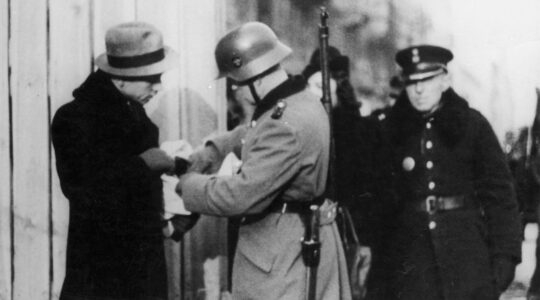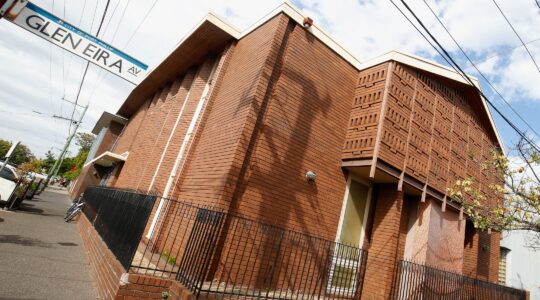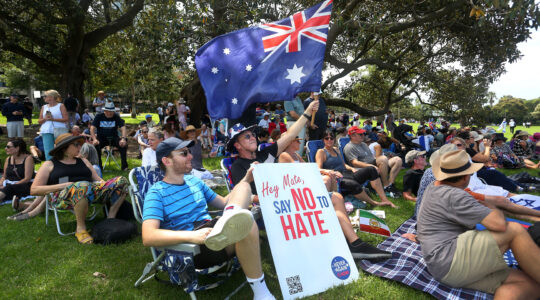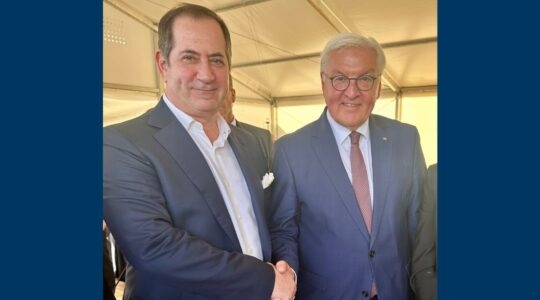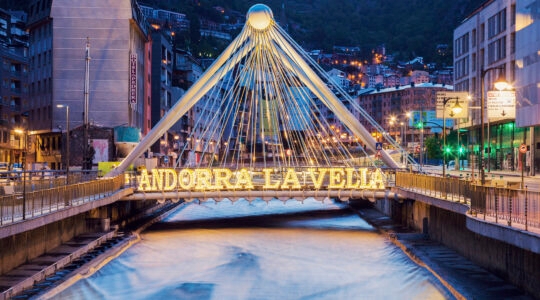PRAGUE, Feb. 12 (JTA) — Build it and they will come. That’s the heartfelt philosophy behind the reopening of what was Europe’s largest yeshiva in Lublin, a Polish city that before World War II was home to 42,000 Jews but which has only a few dozen active Jews today. Nearly 1,000 people showed up to witness Sunday’s unveiling of the renovated Yeshiva Chachmei Lublin, a building with a simple wood-paneled, light-filled synagogue at its heart. It’s the first synagogue in Poland to be reopened with funding solely from Polish Jewry and without government or charitable help. A Chasidic brass marching tune wafted from the monumental building as Jewish leaders standing on a crane unveiled a Hebrew inscription on the building’s facade. The event recalled the day in 1930 when thousands of Lubliners were on hand as the revered Rabbi Meir Shapiro opened his school in a city that had been a center of Orthodox and Chasidic study since the 16th century. “Go my sons, my children, I will teach you how to worship the Almighty, and to have fear of the Almighty,” wrote Shapiro, a great scholar who created the Daf Yomi, the cycle of Talmudic study now followed by observant Jews around the world. Those who danced with vigor amid the yeshiva benches last Shabbat invited fellow Polish Jews to come in from the spiritual cold.”I don’t think there are more Jews out there still afraid to identify as Jews — I know there are, I meet them all the time,” said Piotr Kadlcik, chairman of the Union of Jewish Religious Communities in Poland. “But they will be less afraid when they look at this beautiful synagogue and see that they have a place to go.” The consecration was marked by tears of hope from normally buttoned-up Polish men aching for an expanded Jewish future. Leaders of the Lublin and Warsaw communities that took part in the yeshiva’s $300,000 partial renovation — much remains to be done to restore the 20-room building — are still mulling its use, as it is far too large for the needs of the Jews of Lublin, and perhaps of all Poland. The seven religious Jewish communities in Poland have some 5,000 members in total, though experts say there may be hundreds of thousands more Jews or those with Jewish roots in the country. “We have restored it and people can criticize us for not having a plan, but it is better to try and fail than not to try at all,” said Michael Schudrich, Poland’s New York-born chief rabbi. Some distinguished Polish Jews like Konstanty Gebert, editor of Midrasz magazine, hope the yeshiva “will serve as an international education center for Jewish learning, but also for exchanges where students from the Lublin Catholic Seminary could study for a term.” Others, like Warsaw Jewish community head Piotr Rytka-Zandberg, are focused on opening Europe’s first Museum of the Chasidim and attracting Orthodox Jews from the United States and Israel to visit and study. The building currently houses a small tourist exhibition on the Jews of Lublin. About a three hour drive south of Warsaw, Lublin is a frequent stop for Jewish tourists, and tourism will be essential to maintain the building. The Jewish community received the yeshiva in ruins from city authorities three years ago as part of a communal restitution process that began in 1997. The Warsaw Jewish community, of which Lublin is a branch, was able to use restitution money gained from rents or building sales to support the yeshiva opening, but it will have to rely on international support for further renovation and operation of the building, Rytka-Zandberg said. The yeshiva’s most essential purpose is to serve as a spiritual beacon for Polish Jews, particularly those in Lublin, who were holding Sabbath services in a rundown building where vandals repeatedly broke the windows. That wasn’t lost on Piotr Wajnberg, 29, a Lublin resident with a Jewish father who is in the midst of an Orthodox conversion. The yeshiva opening “is a revival, not just wishful thinking,” Wajnberg said. “Having Shabbat here will have a certain prestige that will attract people.” Another member of the Lublin Jewish community, Szymon Bakalczuk, in his early 50s, recalled how his grandfather was one of the funders of the original yeshiva. Bakalczuk, who was a student at the medical academy that was housed in the building for many decades after World War II, was awed by the transition. “Today the impossible became possible,” he said. The activism of some Lublin Jews is at the core of the small but intensive Jewish revival in Poland, Kadlcik explained.”Twenty years ago, when I started going to the synagogue in Warsaw, everyone was in their 60s. Now, at 45, I am one of the oldest members of the congregation,” he told an audience of Catholic, local government and Jewish leaders Sunday in Lublin. Over the past five years, the number of Jews who are members of the Warsaw community has grown from 300 to about 550 adults.State-sponsored anti-Semitism, as well as negative images of Jews sometimes encouraged by the Catholic Church, once was the norm in communist Poland. The fear of being openly Jewish has greatly diminished since the totalitarian regime fell in 1990, but it’s still a live question for those who survived decades of persecution and do not want to tell their children about their heritage. Schudrich estimated that of the few hundred Shabbat worshipers, only a handful grew up with an openly Jewish identity. Taking advantage of the media spotlight Sunday, Kadlcik pleaded for parents and grandparents to tell their children and grandchildren their real identities. He received moral support from Rabbi Yechiel Kaufman of New York. Representing the Council of the Jewish Community of Borough Park, Kaufman was the only shtreimel wearer at the yeshiva festivities, and his long, white beard and black satin coat gave the proceedings an air of Orthodox formality. Rytka-Zandberg hopes that men like Kaufman will inspire others to support the Polish Jewish revival. Kaufman admitted privately that the memory of the blood spilled on Polish soil during the Holocaust was so painful for some Jews that they were unable to understand today’s Polish Jewish landscape. Photos of former yeshiva students, the vast majority of whom were killed at the Majdanek death camp, reminded the crowds at the reopening that the Meir Shapiro era could never be re-created. Still, the oldest participant in the festivities, 91-year-old Henryk Prejs from Gora Kalwaria — which once was a famous Chasidic enclave known as Ger — was as impressed by the new yeshiva as was the younger generation. “I am delighted, touched and proud that I can now see what I saw 70 years ago,” Prejs said, his eyes moist and his grin inspired. “It makes me cry.”

Help ensure Jewish news remains accessible to all. Your donation to the Jewish Telegraphic Agency powers the trusted journalism that has connected Jewish communities worldwide for more than 100 years. With your help, JTA can continue to deliver vital news and insights. Donate today.

